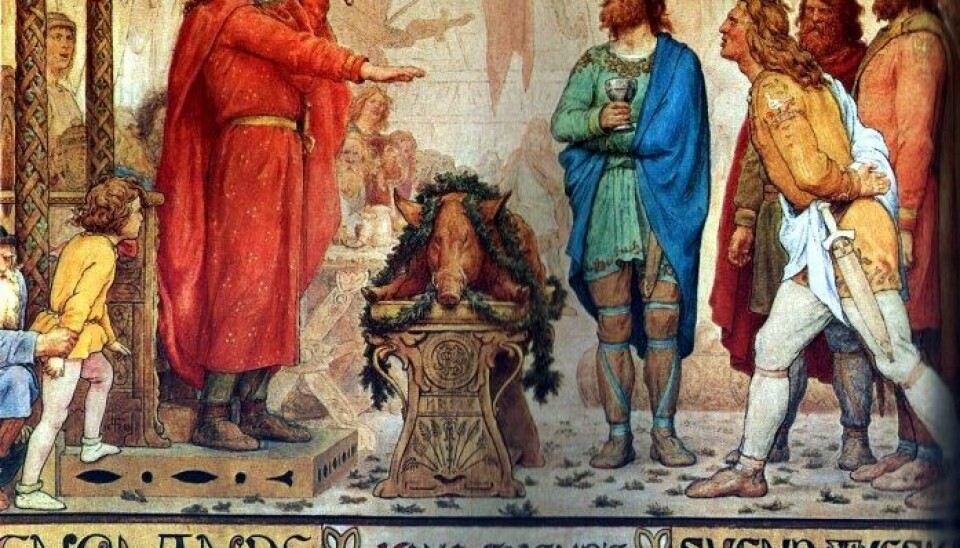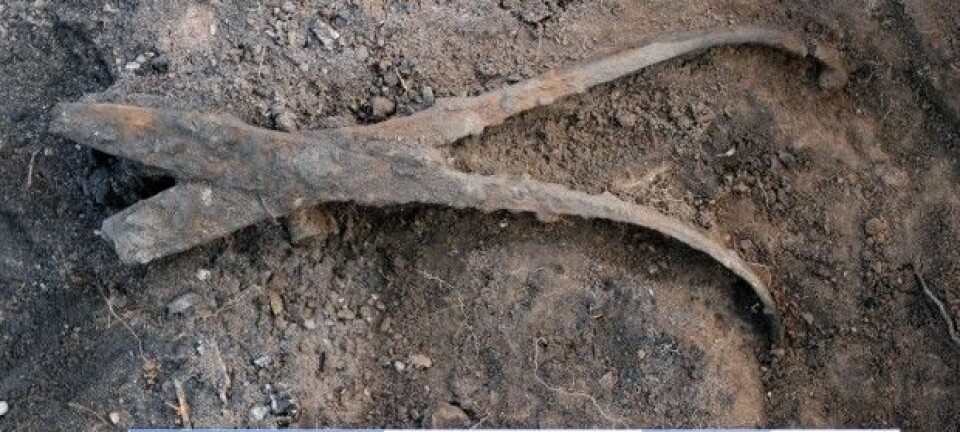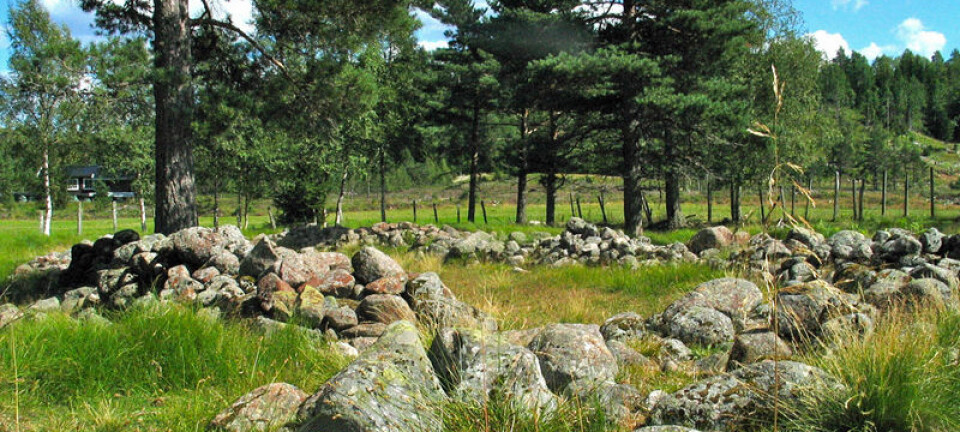
New study reignites debate over Viking settlements in England
A large DNA study in 2015 concluded there is “no clear genetic evidence” of the Danish Viking occupation of England. But thousands of Vikings moved to England, say archaeologists.
The Vikings plundered, raided, and eventually reigned over a large part of what is modern day England. But exactly how many Danish Vikings migrated west and settled down in the British Isles?
In 2015, a large DNA study sparked a row between DNA scientists and archaeologists after concluding that the Danish Vikings had a “relatively limited” influence on the British—a direct contradiction to archaeological remains and historical documents.
“We see no clear genetic evidence of the Danish Viking occupation and control of a large part of England,” write DNA scientists in a study published in the scientific journal Nature in 2015.
A new study has reignited the debate by claiming that somewhere between 20,000 and 35,000 Vikings relocated to England.
Archaeologists: DNA scientists have made a mistake
“We don’t think that the Nature study analysis of the Danish Vikings is correct. We think that they incorrectly interpret the DNA material and that they don’t take into account all of the archaeological discoveries and the knowledge that historians and archaeologists have gathered concerning the Danish Vikings in England,” says co-author Jane Kershaw, an archaeologist and Viking researcher Jane Kershaw, a post doc at the University College London.
The new study is published in the archaeological journal Antiquity.
In it, Kershaw and her colleague argue that evidence collected from language studies, written sources, and archaeological discoveries indicate a “large-scale Danish Viking presence in England,” says Kershaw.
Read More: See where the Vikings travelled
“It all fits together beautifully”
The new result is pretty much what Viking researcher Søren Sindbæk, a professor at the School of Culture and Society from Aarhus University, Denmark, had expected.
“It’s very interesting because it gives a very precise estimate of how many Vikings that moved to England. Both their analysis of the genetic material and archaeological remains indicate that the Danish Vikings had quite a significant influence,” says Sindbæk.
“It all fits together beautifully and I’m in total agreement with their critique of the original DNA study conclusions about the Vikings,” he says.
Sindbæk was not involved in either of the two studies, but has closely followed the debate about the influence of Vikings in England.
“20,000 to 35,000 Vikings moving to England might not sound like much to us. But remember that this was before flying, cellphones, and GPS. In the Viking times it was quite a significant migration,” says Sindbæk.
Read More: Old DNA reveals Viking impacts on flora and fauna
Explore the time-line above to follow the Danish Viking travels to England (Graphic: Mette Friis-Mikkelsen / ScienceNordic)
A long running debate
Archaeologists and historians have debated the numbers for decades with no consensus, writes Viking researcher and archaeologist Steve Ashby from the University of York in an email to ScienceNordic.
But more recent archaeological discoveries convinced many researchers that a large-scale resettlement took place, he writes. He was not involved in the new study.
“Recently we’ve started to believe that the settlement was towards the larger end of the estimates that have been made, and the suggestion of between 20,000 and 35,000 settlers is in line with this,” writes Ashby.
Read More: Unique Viking tomb contains remains of noble couple
Did the Vikings take their wives to England?
Language research and historical records confirm a large-scale immigration, says Sindbæk.
“The English language is testament to a massive influx of Scandinavians. One of the most important written sources—the famous Domesday Book from the end of the 11th century—records the owners of almost all farms in England. In the records, you can see that a part of the population in a large part of England has Scandinavian names or names that aren’t traditionally seen as English but that we encounter in Denmark,” he says.
Kershaw agrees.
“A lot of place names in England have Scandinavian –specifically Danish- origins. And we’re not just talking about large towns or places. Fields, hedges, small streams, and other rural landscape features have Scandinavian names, suggesting that they were named by a Norse-speaking population, living in the countryside and working the land,” she says, adding that she has spent “my academic career to date arguing that thousands of Vikings settled in England.”
Read More: Dressed up with jewellery stolen in Viking raids
Archaeologist "shocked" by the DNA
Kershaw was shocked when she read in British media that a new DNA study showed that Danish Vikings had very little influence on British genetics.
“When I first read the Nature study I was a little shocked. I thought, “No, it simply doesn’t fit.” All of my own research is based on completely the opposite argument that there were a lot of Vikings—both men and women-- that settled in England,” says Kershaw.
She immediately called her friend Ellen Røyrvik, a geneticist at the University of Warwick, UK, who was one of the co-authors on the 2015 study.
“Ellen explained that, in her opinion, there were many problems with the study’s interpretation of the DNA data concerning the Danish Vikings. This ended up being the reason why we collaborated to write a response, which is the study that’s just been published in Antiquity,” says Kershaw.
The original DNA study in Nature provides a genetic map of the British population and both Kershaw and Røyrvik stress that their criticism does not apply to the whole study—only to the conclusions that relates to the Danish Vikings.
“The data are excellent, I just feel the interpretation is too simplistic,” says Røyrvik.
Read More: What colour did the Vikings paint their houses?
DNA scientists confident in interpretation of Viking DNA
The Nature study concluded 20 per cent of the British DNA comes from the Anglo-Saxons who had come from Germany and invaded England in the 5th and 6th centuries. The study concluded that they largely mixed with the existing population.
They concluded that it was difficult to isolate the influence of the Danish Vikings just by looking at the DNA material.
“We’re quite confident that the Danish Vikings didn't leave much DNA in the UK population,” says Peter Donnelly, lead-author on the Nature study and director of the People of the British Isles project, which supplied the genetic data for the Nature study.
Read More: Replica Viking ship will recreate Norse voyages in Greenland
Studied modern European DNA
In the study, Donnelly and his colleagues compared genetic material of the contemporary British population with genetic material from current populations in other parts of Europe.
“One of the reasons why we say we don’t see a clear signal from the Danish Vikings is that we know that the Danish Vikings occupied certain parts of Britain. They controlled a large area, which was known as the Danelaw for more than 100 years. So if the Vikings had left behind significant traces of DNA, we would expect to see them in these areas and not in all areas of the UK. But that's not the case,” says Donnelly.
His co-author, Røyrvik, disagrees.
“I don’t agree that Danish Viking DNA should be limited to certain areas,” says Røyrvik.
“People have moved around since the Viking Age and people have had children with people in different areas. So the idea that Viking DNA is just limited to one or two areas in England doesn’t really make sense to me. The DNA study shows itself that there’s been lots of mixing in the lowlands of England, so it would be strange if the DNA was limited to the Danelaw,” she says.
Read More: Fashionable Vikings loved colours, fur, and silk
Scientists disagree on how to identify Danish Viking DNA
Their mistake, according to Røyrvik, is the way in which they differentiate between the Anglo-Saxon and Danish Viking DNA. A part of the genetic input that they describe as Anglo-Saxon actually probably has a Danish origin, she says.
“I think that the population that they think reflects Anglo-Saxons, also includes Danish Vikings. The arguments that they use to establish that it doesn’t apply to Danish Vikings don’t hold up,” says Røyrvik.
She points out that the Anglo-Saxons invaded England in the 5th century, but they originally came from northern Germany, close to Jutland in West Denmark, where the Vikings later prospered.
“It’s difficult to separate Danish Vikings and Anglo-Saxons genetically because these populations lived so close together. And at the same time, the Vikings arrived in England relatively soon after the Anglo-Saxons. This leads to extra uncertainty and it means that you can’t separate the two,” says Røyrvik.
Read More: DNA study: Vikings were plagued by intestinal parasites
“Impossible” to separate Anglo-Saxon and Viking DNA
Donnelly was aware of the uncertainties surrounding this separation of Danish Vikings and the Anglo-Saxons when the study was originally published.
“Definitively separating Saxon and Danish Viking [genetic] inputs is impossible,” they write in the supplementary material accompanying the study.
But they still write that “we thus think it likely” that Danish Vikings only left limited traces of their DNA in the modern British population because “we see no remnant of the Danelaw, in terms of a distinct genetic cluster within the UK.”
Donnelly adds:
“It’s true that we cannot exclude that the Vikings’ descendants have moved around so much that we can no longer see the signal from the Vikings in certain areas. But they should have moved around a lot for such a genetic signal to be erased. And we quite clearly see the genetic signals from other events that took place thousands of years before the Vikings came to England.”
“But of course no one can say anything definitive. We’re trying to reconstruct events that happened over 1,000 years ago based on modern human DNA,” says Donnelly.
Read More: What Vikings really looked like
Danish DNA from Copenhagen hospital patients
The modern Danish DNA comparison was made using DNA samples from hospital patients in Copenhagen. But these may not have been the best choice to represent Danish Vikings, says Røyrvik.
“In mapping the British DNA, we went to great lengths to select the participants. For example, you could only take part if you had four grandparents that all came from the same small area of Britain. But we couldn’t apply the same high standards to the DNA material that we got from all the other countries,” she says.
“The material from Denmark only came from Copenhagen and perhaps it’s not the best representation of Vikings, geographically speaking. We don’t know if some of the patients were immigrants to Denmark from other countries or if their grandparents were foreign,” she says.
Read More: New signs of pre-Viking life on the Faroe Islands
Discussion shouldn’t overshadow an impressive study
She points out that she opposed the conclusions about the Danish Vikings before the study was published.
“But there were a lot of authors on the Nature study, and you don’t always get all the details as you’d like,” says Røyrvik. “But I want to emphasise that I agree with most of the findings in the study--just not when it comes to the interpretation of data on the Danish Vikings. The data in this study are excellent, but it lacks in the interpretation and understanding of the Vikings.”
DNA scientist Professor Rasmus Nielsen, from the Center for Theoretical Evolutionary Genomics at the University of California, Berkeley, USA, has read both the Nature study and the criticisms in the new Antiquity study.
He emphasises that the Nature study methodology is both ground-breaking and innovative, but:
“In relation to the part of the conclusions that relate to the Danish Vikings, I agree that they have probably pushed the interpretation of their results a bit further than what the data can support,” says Nielsen.
“But I hope that this doesn’t overshadow that technically speaking, it’s a very impressive study,” he says.
Read More: Norwegian viking saga confirmed by archaeological discovery
Do the two studies contradict each other entirely?
Donnelly suggests that there’s not a big difference between the findings of the two studies.
His study does not put a figure on the number of Vikings that came to England. They simply report a “relatively limited input of DNA from the Danish Vikings.”
“I'm not sure that we contradict each other--it's all just a matter of numbers,” he says. “Even if 25,000 Danish Vikings moved to England in the period, they would still only represent a small share of the total UK population. For example, if the British population back then was 500,000 people in the areas that the Vikings occupied, then the Danish Vikings would still only account for five percent of the population,” says Donelly.
“So it's not so surprising that we do not see any clear genetic signal from them more than 1,000 years later,” he says.
Read More: Viking fortress in Denmark stumps archaeologists
There is Danish DNA in the UK
“We’re not saying that there is no DNA from the Danish Vikings in the British population--we just say that the Danish Vikings have not left a significant signal. Anglo-Saxons left a clear DNA signal, but the Vikings did not,” says Donelly.
“But we also see no signal from the Normans for example, even though they invaded and took over the UK. They didn't have enough children with the locals to leave a clear genetic signal today. The only migration to Britain since the time of Christ, that has left a clear genetic signal, is from the Anglo-Saxons,” he says.
Røyrvik maintains that the Nature study misinterprets the data.
“Based on the analysis in the Nature study, I don’t think that we can say that Ango-Saxons have had a significant impact on modern British DNA, and that Danish Viking have not,” she says.
Read More: Archaeologists discover a Viking toolbox
Vikings were hugely influential
We will probably never know how many people moved from Viking Denmark to England. And even if the Danish Vikings did not leave a significant genetic imprint, they certainly left a cultural impact, writes Ashby.
“The question of the numbers of Scandinavian settlers in England has rattled on for decades, without any real solution.”
“To be honest, I don't find counting the number of settlers to be a very interesting question in itself. What is clear is that however many there were, Scandinavian settlers had a huge impact on the society and culture of what was to become England,” he writes.
Translated by: Catherine Jex
Scientific links
- "The fine-scale genetic structure of the British population", Nature 2015, doi:10.1038/nature14230
- "The ‘People of the British Isles’ project and Viking settlement in England", Antiquity, 2016, DOI: https://doi.org/10.15184/aqy.2016.193









